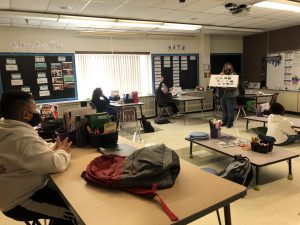School Spotlight: Evergreen Park STEM School of Innovation
Like many schools in Minnesota, the start of the 2020 school year has been out of the ordinary for Evergreen Park Elementary in Brooklyn Center.
“We’re learning as we go and trying to adapt and change and meet our families’ needs as we go also,” said Denise Schnabel, Evergreen Park’s principal.
The school is currently in a hybrid model with many families opting for full-time distance learning. The current format means that from Tuesday through Friday, there’s only about 100 students in the building.
“We have our masks,” Schnabel said. “The kids have been amazing in learning the new routines to make sure that everybody stays safe, and they seem to really understand why and the purpose of why we are doing all that. So they’re helping us all out and keeping everybody safe.”
Yet the pandemic isn’t the only reason why this year is a little different at the Brooklyn Center school.

Evergreen Park is currently in a hybrid learning model, but many families opted to go to distance learning this school year.
Shifting its magnet school focus
After two years of planning, the school underwent a transformation. Instead of branding itself as a “World Cultures School,” Evergreen Park is now a “STEM School of Innovation.”
“I think that what people will start to see in the future is that there’s a lot more hands-on learning, a lot more excitement for the kids around just the thinking processes that they can use,” Schnabel said. “It’s not only tied into our science and our math and our technology, but we’re tying it into our reading and into our social studies.”
When the Anoka-Hennepin School Board initially approved the switch two years ago, nobody knew that the launch would coincide with a global pandemic. So 2020 is acting as a soft rollout for the science, technology, engineering and math focus.
Caitlin Meyer is helping teachers with the transition.
“We all are in this together and doing the best we can, and they are doing some really amazing work to persevere through the challenges and the barriers that have come,” Meyer said. “We are still providing really amazing things for our kids, it just might be in a different format than we’d like.”
For example, students at each grade level have their own specific focus. The fifth graders are innovators, so one activity they’ll do involves taking a box and turning it into something new.
The students in distance learning, however, just have to use the resources available to them at home.
“They were encouraged to find a cereal box or find a box you might have gotten from a package you received,” Meyer said. “And then use materials at home in order to create something new and different.”
The classes will look different and more hands-on whenever they’re able to get all students back in the building. But for now, they’re working to perfect a curriculum that will benefit students for years to come.
“Our kids deserve it,” Schnabel said. “Our kids deserve this opportunity to have these other pieces that come into them and support their learning, and it’s exciting for them.”


